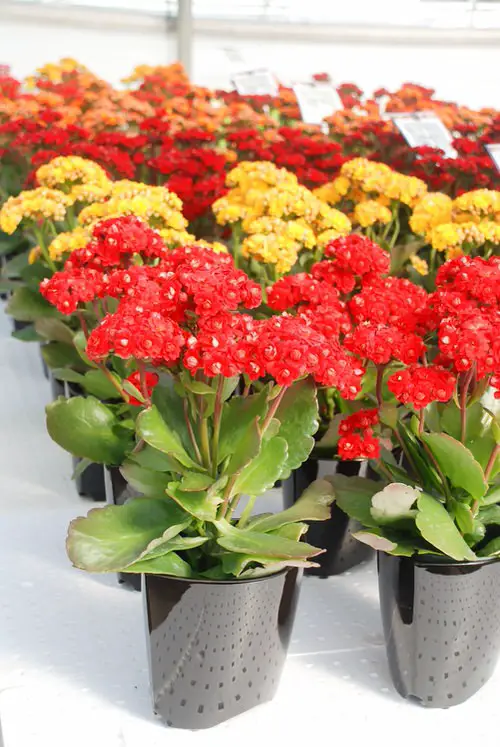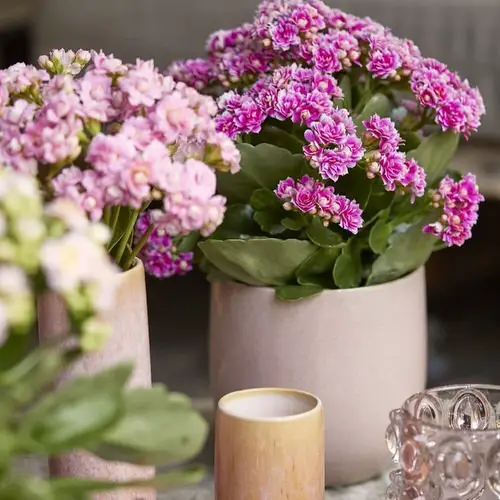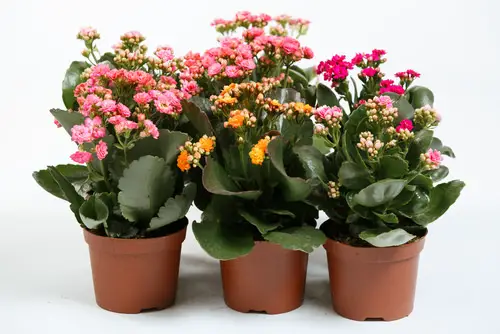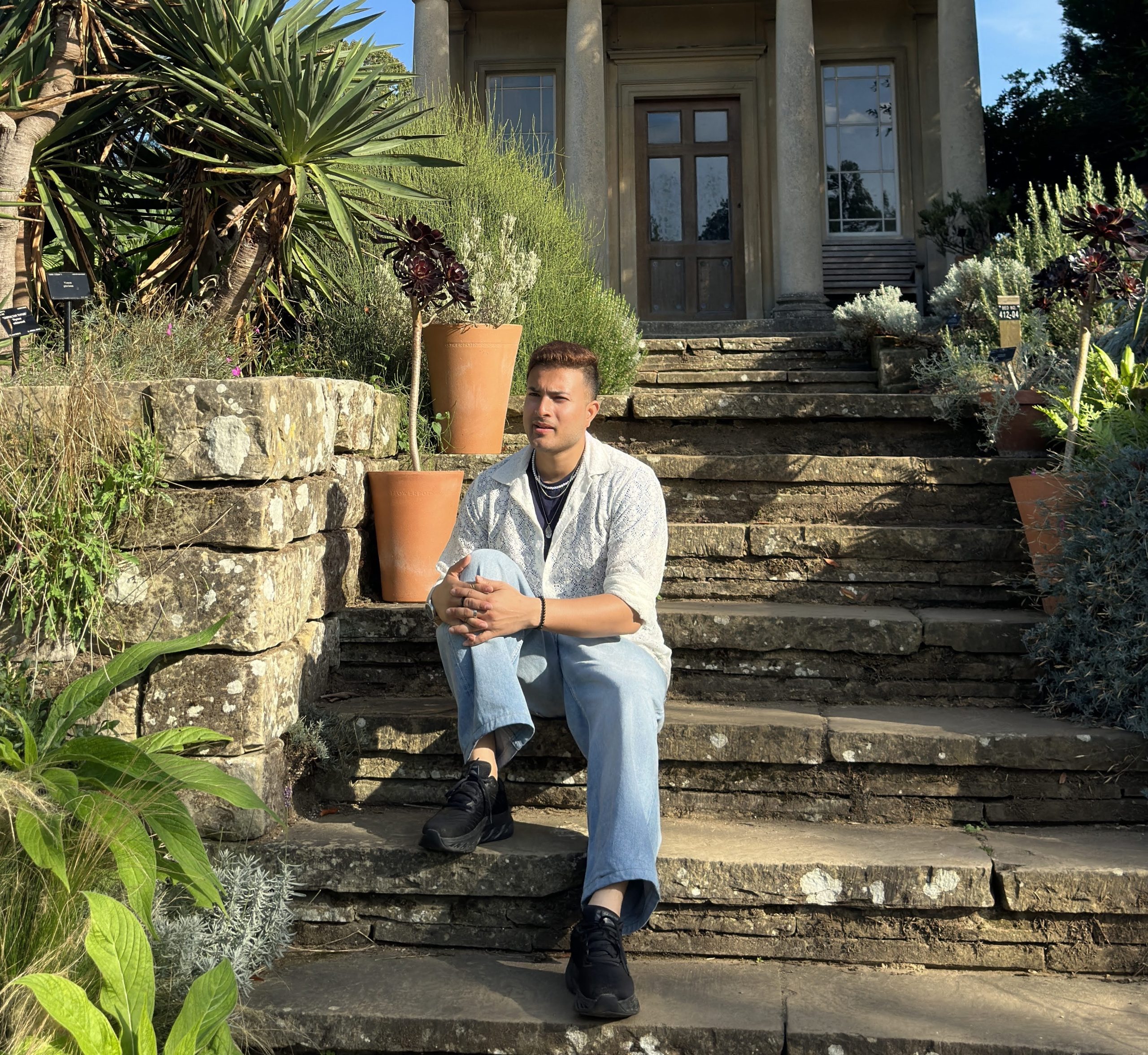Want to know about the best secrets on How to Make a Kalanchoe Flower More? Learn what you should do in easy steps to have this succulent blooming year-round!

Kalanchoe blossfeldiana or Florist Kalanchoe, is one of the best flowering succulents that you can easily grow outdoors or indoors. The best part is–the blooms are long-lasting and won’t fade soon! So, if you have one and want to know How to Make Kalanchoe Flower way more than it does, read ahead!
Learn how to grow Kalanchoe plant indoors here
When Do Kalanchoes Flower?
Before answering this question, let’s remind you that when it comes to blooming, flowering kalanchoes are a lot like poinsettias, which means they are photoperiodic, and their flowering depends on the day’s length.
While growing as a houseplant, kalanchoes can flower in winter (more accurately, late winter) and spring. However, it may get obstructed when lighting increases. Generally, these plants bloom in their native climate from the autumn end and winter and up to spring, when the day length shortens. Some varieties even continue to display long-lasting flowers till summer.
Why is Your Kalanchoe Not Blooming?
The reason behind your non-flowering kalanchoe is the natural dormancy or hibernation they need. It’s inherent for them to lose their blossoms at some stage since they require some break to flower again.
Based on the time of year and length of the days, kalanchoes go into a dormancy period that makes you think that the plant won’t flower again, which is not true! The 6 weeks dormancy period can be provided artificially by adjusting the length of daylight by shortening it like winter.
Treat your eyes to the most beautiful Kalanchoes on Instagram here
How Long Does It Take for Kalanchoe Buds to Flower?
The kalanchoe plants require at least 11-14 hours of darkness for a straight 6-8 weeks to activate flowering again. Put it in a cabinet or closet overnight (from 6 PM to 8 AM), and cut down on watering and fertilizing at this time.
After a few weeks, you will see the arrival of colorful flowers. This flowering period can last up to 6 months!
Give the plant plenty of direct and indirect sunlight during the daytime, maintain warmth, and safeguard it from drafts and cold temperatures.
Kalanchoe Flowers Appearance

Kalanchoe displays blooms in many shapes and hues of magenta, red, pink, orange, white, and yellow. The four-petaled blossoms in clusters above the waxy, thick, deep green scalloped-margined leaves. It also comes in a double-flowering variety.
Flowering kalanchoe blooms for at least eight weeks, and flowers don’t fade for months, which is a symbolical meaning of eternal love and persistence.
Check out some stunning Kalanchoe varieties to grow indoors here
How to Make Kalanchoe Flower

1. Imitate a Dormancy Period
Like poinsettias, kalanchoes need short day lengths (long nights) to develop flowering buds. To trick the plant, keep it in a completely dark room at night. You will have to ensure it doesn’t even get a fraction of any natural or artificial light source.
In the morning, place the plant where it gets direct sunlight for 2-4 hours and then filtered sun or bright shade.
Continue to do this for 6-8 weeks, and soon, you will see the plant growing flower buds.
Note: It is very much possible that if you miss out on even a single night of darkness, the plant won’t produce any flowering buds.
Learn how to induce flowers on Birds of Paradise here
2. Provide Plenty of Light
Once you take out the plant from a dark room after night, it is essential that you provide it with plenty of sunlight, a minimum of 4-5 hours, to say the least, during the daytime. Make sure you are not keeping it in a shaded spot during the day. If you fail to provide it with direct sunlight as suggested, then it won’t develop flowering buds.
3. Expose Your Plant to a Low Temperature
Another important factor to consider is to keep plants moderately cool. Do not expose them to temperatures above 59 F (15 C) anytime during this period. Keep the plant away from A/C or heating vents, though.
Get the best tips to flower a Jade plant here
4. Cut Down Watering
During the artificial dormancy, you will have to make sure that you are cutting down the watering. Water your plant after 3 weeks of following the routine of darkness in the night and light during the day.
5. Avoid Fertilizing Your Plant
During the entire time of dormancy, avoid feeding the plant. Once you start to see the flowering buds appear, feed the plant with a 0-10-10 liquid fertilizer diluted to half of its strength.
Feeding the plant after the development of the buds will ensure vivid color, better flowering, and good health.
Check out the best homemade liquid fertilizer recipes here
After Care

- Once you see the plants full of flowering buds, then it is time to stop keeping them in complete darkness during the nighttime.
- Start watering the plant well, but of course, repeat the next time when the soil is dry to the touch.
- Make sure it gets plenty of direct sunlight in your home, too. The more, the better.
- Keep snipping off the spent flowers to help the plant direct its energy into the development of new buds.
- The best part is–the flowers stay for 4-6 weeks, and if you take the right care, you can extend this time even more!
Check out our article 10 Common Snake Plant Problems and How to Fix Them here
FAQs
1. How can I encourage my Kalanchoe to bloom more frequently?
Kalanchoe plants are often triggered to bloom by shorter daylight hours. To encourage more frequent blooming, give your Kalanchoe 12-14 hours of darkness each day for 6-8 weeks. This mimics the natural conditions that induce flowering.
2. What type of lighting conditions are perfect for Kalanchoe flower production?
Kalanchoes thrive in bright, indirect sunlight. Placing your plant near a south or west-facing window with filtered sunlight during the day can help promote abundant blooms.
3. How often should I water my Kalanchoe to encourage blossoming?
Kalanchoes prefer to dry out slightly between waterings. Water thoroughly when the top inch of soil feels dry to the touch. Overwatering can lead to root rot and hinder flowering.
4. Should I fertilize my Kalanchoe to stimulate more blooms?
Yes, fertilizing your Kalanchoe with a balanced, water-soluble fertilizer during the growing season (spring and summer) can help encourage more blooms. However, avoid excessive fertilization, as it may lead to lush foliage at the expense of flowers.
5. How to Get Kalanchoe to bloom year-round, or does it have specific flowering seasons?
Kalanchoes typically have specific flowering seasons, with the most common time being late winter to spring. After a flowering cycle, they may need a rest period before blooming again. With proper care and conditions, you can extend this blooming season though. However, continuous year-round blooming may be tough to achieve.


